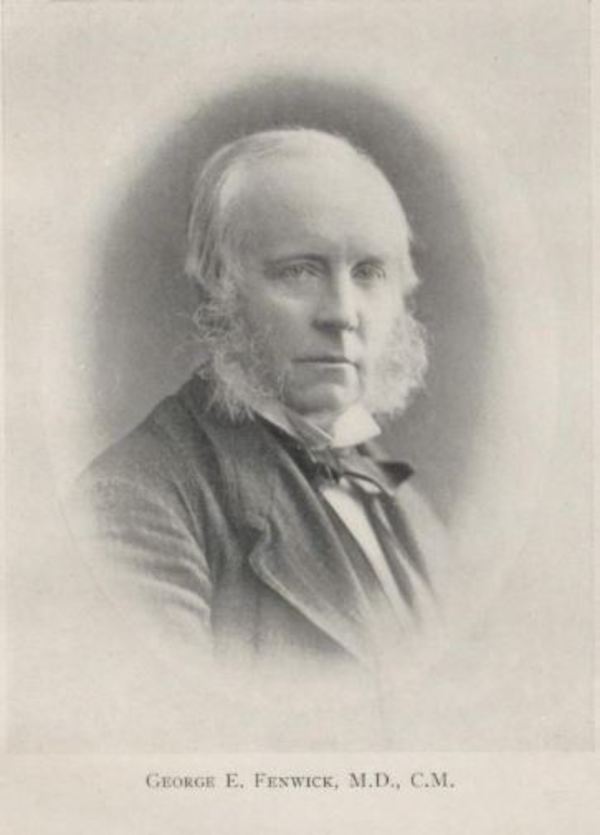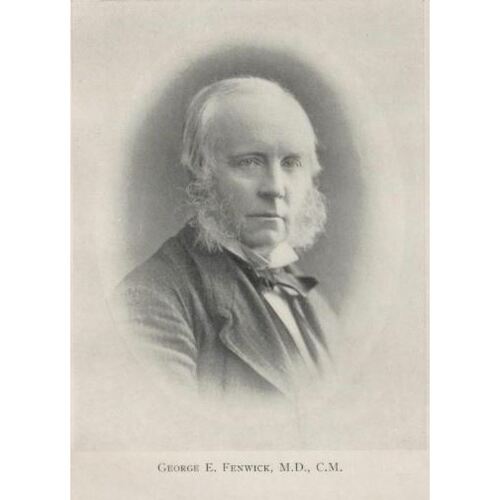
Source: Link
FENWICK, GEORGE EDGEWORTH, surgeon, educator, editor, and author; b. 8 Oct. 1825 at Quebec, son of Joseph Fenwick, assistant harbourmaster, and Margaret Elizabeth Greig; m. 1852 Eliza Charlotte de Hertel, and they had seven children, only one of whom survived their father; d. 26 June 1894 in Montreal.
George Edgeworth Fenwick was initially educated at the school of the Reverend James Ramsay, a Church of England priest at Quebec. Fenwick commenced his medical training in that city under James Douglas*, and in 1841 he served as an apothecary at the Marine and Emigrant Hospital under his brother, Alexander Greig, a house-surgeon. The following year George enrolled as a medical student at McGill College. By June 1846 he had fulfilled all the requirements for graduation except one; he was not yet 21. That obstacle was eliminated in October, and on 29 Jan. 1847 a special convocation conferred on him the degree of md. In May he was appointed apothecary and house-surgeon at the Montreal General Hospital. However, he clashed with hospital officials over keeping a dog in his room (“to the annoyance of the servants”) as well as over his insistence on eating at a separate table, so that by the end of 1848 he had left to open a general practice in Montreal. In 1850 he was among the founders of the Montreal Dispensary. The following year he and Robert Palmer Howard* became instructors in the St Lawrence School of Medicine, where Fenwick taught materia medica and pharmacy. Established as a rival to the medical faculty of McGill College, the school survived only one session.
In 1864 Fenwick was appointed attending physician at the Montreal General Hospital, and the same year he became demonstrator of anatomy at McGill. He was also surgeon to the Volunteer Militia Field Battery of Artillery of Montreal and was on service with it during the Fenian raids of 1866 and 1870. Although he had continued in general practice, it was evident that Fenwick had special ability in surgery, and his talent was recognized formally in 1867 when he was appointed professor of clinical surgery and medical jurisprudence at McGill. Following the retirement of George William Campbell*, Fenwick was widely recognized as the best surgeon in Montreal, and he became attending surgeon at the Montreal General Hospital in 1882 and chief surgeon later.
Fenwick gained his surgical experience largely in pre-antiseptic days. According to one of his students, Francis John Shepherd, he operated “in an old blood-stained black frock coat.” “The only precautions taken . . . were to wash the hands; the instruments and the patient were not specially cleansed,” remarked Shepherd. But Fenwick, aware of the dangers of infection, operated only after “due consideration” and only to cure, never to explore. When he did operate he was “bold,” “well up in his anatomy,” and “very practical in his directions,” so that he had “much more success than those who had more scientific knowledge.” Shepherd also noted Fenwick’s scorn for “meddlesome” surgeons. After operating, Fenwick would “not bother much about the case, perhaps go away for a day, and yet the patient would get well”; more solicitous surgeons continually checked the wound, “like digging up a seed to see if it was growing,” and their patients often died.
In the 1870s Fenwick began excision operations on knee bones in order to reduce amputation above the knee, a procedure with great danger of fatal post-operative infection. By excision he cut out diseased parts of the bone or bones and fused what remained. According to Shepherd, Fenwick had little success until 1877 when Thomas George Roddick*, back from studies in Britain with Joseph Lister, introduced Lister’s antiseptic methods to the Montreal General Hospital. In spite of the scepticism of some colleagues, Fenwick immediately embraced “Listerism,” and his excision operations began to succeed. These results enabled him to launch a strong attack on the champions of amputation, chiefly through a work entitled Excision of the knee joint with report of twenty-eight cases. He became prominent as well for excision of malignancy of the rectum and for removal of urinary stones and of large tumours of the neck. He published many articles on his surgical procedures, some of which were regarded as innovative. He was an avid collector of pathological specimens for McGill’s medical museum.
Fenwick’s interest in medicine and medical education was broad. As a teacher he impressed his students with an extensive surgical experience. According to Shepherd, he taught his students to think for themselves and not to be slaves to authority. From 1864 Fenwick edited the Canada Medical Journal and Monthly Record of Medical and Surgical Science (Montreal) with Francis Wayland Campbell*. The two parted company in 1872, possibly over differing institutional allegiances, Campbell’s loyalty being to the faculty of medicine of Bishop’s College. That year Fenwick founded the Canada Medical & Surgical Journal (Montreal), which he edited until 1879. His prominence and wide interest led him to the presidency of the Montreal Medico-Chirurgical Society in 1876–77 and of the Canadian Medical Association in 1881–82, and for many years he represented the profession in Montreal in the College of Physicians and Surgeons of Lower Canada. A Conservative in polities, he was an active Anglican and enjoyed a long and close association with the parish of St John the Evangelist.
Fenwick was loved by everyone, including his students, according to Shepherd, for he had “a kindly, open face and a charming benevolent manner.” He could become irascible, but then would be so painfully ashamed and so apologetic that “no one could be long angry.” Having no idea of time, he was dubbed “the late Dr Fenwick,” and, being as little concerned about money, he was “always hard up.” He submitted bills “when he wanted the money badly.” Once, after he had a long illness, colleagues subscribed $1,000 to send him on a holiday; he spent $600 on a piano and with the remainder travelled as far as he could. Late in life he could be seen “driving about Montreal in his fur coat and blowing his nose à la Stentor, with an array of bandana handkerchiefs.” He continued to practise surgery in old age, but he had lost his nerve, and Shepherd asserts that sometimes he himself had to finish an operation at which he was assisting.
Fenwick retired from McGill in 1890 as emeritus professor of surgery. For years he had suffered from arterial sclerosis, and he died of a cerebral haemorrhage on 26 June 1894. Colleagues commissioned a painted window and a tablet in the Church of St John the Evangelist. Sir William Osler*, another of his students, remembered Fenwick less formally. “What an old darling he was!”
George Edgeworth Fenwick is the author of Excision of the knee joint with report of twenty-eight cases (Montreal, 1883). A portrait of Fenwick by Robert Harris* is located in the Strathcona Anatomy and Dentistry Building, McGill Univ., and a photograph is reproduced in F. J. Shepherd, Reminiscences of student days and dissecting room (Montreal, 1919), and in H. E. MacDermot, “History of Canadian surgery: George Edgeworth Fenwick (1825–1894),” Canadian Journal of Surgery (Toronto), 11 (1968): 1–4.
ANQ-M, CE1-70, 28 juin 1894. ANQ-Q, CE1-61, 29 janv. 1826. McGill Univ. Arch., MG 2028; RG 14; RG 38. McGill Univ. Libraries, Osler Library, Acc.603; Acc.612. Mount Royal Cemetery Company (Outremont, Que.), Burial reg. Montreal General Hospital, Annual report, 1865–93. An annotated bibliography of Canadian medical periodicals, 1826–1975, comp. C. G. Roland and Paul Potter (Toronto, 1979). Borthwick, Hist. and biog. gazetteer. Canadian biog. dict. Cyclopædia of Canadian biog. (Rose and Charlesworth). H. A. Kelly and W. L. Burrage, Dic tionary of American medical biography: lives of eminent physicians of the United States and Canada from the earliest times (New York and London, 1928). McGill Univ., Faculty of Medicine, Calendar (Montreal), 1865–94. Abbott, Hist. of medicine. H. [W.] Cushing, The life of Sir William Osler (2v., Oxford, 1925; repr. in 1 v., London and Toronto, 1940). [W. H. Davison], The Church of St. John the Evangelist, Montreal, 1878–1928: a historical record in commemoration of the jubilee of the parish church ([Montreal, 1928]), 58. H. E. MacDermot, A history of the Montreal General Hospital (Montreal, 1950). F. J. Shepherd, Origin and history of the Montreal General Hospital ([Montreal, 1925]), 43–44. “Dr. G. E. Fenwick,” Ontario Medical Journal (Toronto), 2 (1894): 430–31. “Prof. Geo. E. Fenwick, M.D,” Montreal Medical Journal, 23 (1894): 77–79.
Cite This Article
Edward H. Bensley, “FENWICK, GEORGE EDGEWORTH,” in Dictionary of Canadian Biography, vol. 12, University of Toronto/Université Laval, 2003–, accessed April 29, 2025, https://www.biographi.ca/en/bio/fenwick_george_edgeworth_12E.html.
The citation above shows the format for footnotes and endnotes according to the Chicago manual of style (16th edition). Information to be used in other citation formats:
| Permalink: | https://www.biographi.ca/en/bio/fenwick_george_edgeworth_12E.html |
| Author of Article: | Edward H. Bensley |
| Title of Article: | FENWICK, GEORGE EDGEWORTH |
| Publication Name: | Dictionary of Canadian Biography, vol. 12 |
| Publisher: | University of Toronto/Université Laval |
| Year of revision: | 1990 |
| Access Date: | April 29, 2025 |



